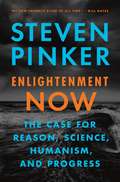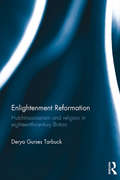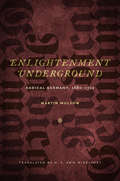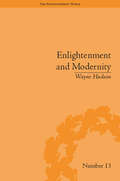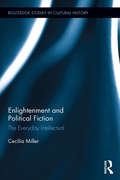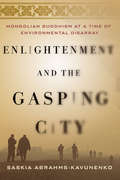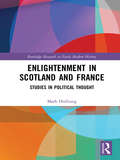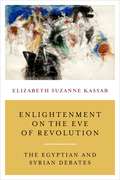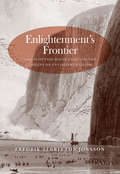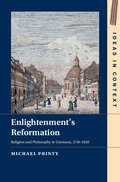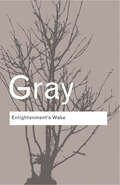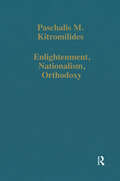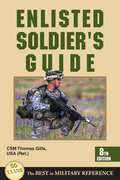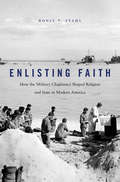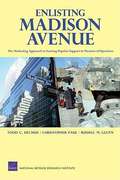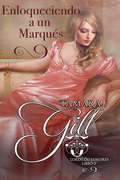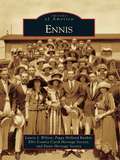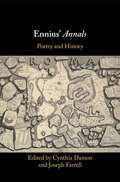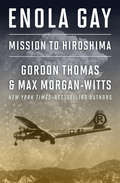- Table View
- List View
Enlightenment Now: The Case for Reason, Science, Humanism, and Progress
by Steven PinkerIs the world really falling apart? Is the ideal of progress obsolete? In this elegant assessment of the human condition in the third millennium, cognitive scientist and public intellectual Steven Pinker urges us to step back from the gory headlines and prophecies of doom, which play to our psychological biases. Instead, follow the data: In seventy-five jaw-dropping graphs, Pinker shows that life, health, prosperity, safety, peace, knowledge, and happiness are on the rise, not just in the West, but worldwide. This progress is not the result of some cosmic force. It is a gift of the Enlightenment: the conviction that reason and science can enhance human flourishing. Far from being a naïve hope, the Enlightenment, we now know, has worked. But more than ever, it needs a vigorous defense. The Enlightenment project swims against currents of human nature--tribalism, authoritarianism, demonization, magical thinking--which demagogues are all too willing to exploit. Many commentators, committed to political, religious, or romantic ideologies, fight a rearguard action against it. The result is a corrosive fatalism and a willingness to wreck the precious institutions of liberal democracy and global cooperation. With intellectual depth and literary flair, Enlightenment Now makes the case for reason, science, and humanism: the ideals we need to confront our problems and continue our progress.
Enlightenment Orientalism in the American Mind, 1770-1807 (Perspectives on Early America)
by Matthew H. PangbornThis study engages with the emerging field of energy humanities to provide close readings of several early American oriental-observer tales. The popular genre of orientalism offered Americans a means to critique new ideas of identity, history, and nationality accompanying protoindustrialization and a growing consumerism. The tales thus express a complex self-reflection during a time when America’s exploitation of its energy resources and its engagement in a Franco-British world-system was transforming the daily life of its citizens. The genre of the oriental observer, this study argues, offers intriguing glimpses of a nation becoming strange in the eyes of its own inhabitants.
Enlightenment Political Thought and Non-Western Societies: Sultans and Savages (Routledge Studies in Social and Political Thought)
by Frederick G. WhelanFrederick G. Whelan, a leading scholar of Enlightenment political thought, provides an illuminating and incisive interpretation of key eighteenth and nineteenth century European political thinkers' accounts and assessments of the societies and political institutes of the non-Western world. These writers opened up a major new comparative dimension for political theory and its project both to explain and evaluate different political regimes. While the intellectual confrontation of European thinkers with alien cultures tended on the whole to confirm Westerners' sense of the superiority of their own institutions, it was also characterized – during the Enlightenment more so than later – by convictions regarding a common humanity and a corresponding sympathetic curiosity about different ways of life, however primitive or exotic they might appear. This book will be of interest to students and scholars of both political philosophy and thought as well as historians of this important period of history.
Enlightenment Reformation: Hutchinsonianism and Religion in Eighteenth-Century Britain
by Derya Gürses TarbuckTaking a fresh and imaginative approach to the topic, Enlightenment Reformation investigates how and why Hutchinsonianism came into being, evolved and eventually ended. In surveying the history of this intellectual movement, it explores the controversies in and around religion that sat at the very centre of the Enlightenment period in Britain. During the eighteenth century, many opponents of Isaac Newton's cosmology and natural religion gravitated to the writings of John Hutchinson (1674–1737). United by a strong belief in the Christian Trinity and a particular approach to the reading of Hebrew Biblical texts, the essential tenets of Hutchinsonianism remained for over a century the main source of opposition to Enlightenment scientific theories. Integrating the various aspects of Hutchinsonianism that together help to define the movement, this book first critiques the existing historiography on the subject and second provides an overview of the movement’s thought, growth and downfall. This volume offers a fascinating perspective on the role of religion, science and ecclesiastical history in eighteenth-century thought and will be valuable reading for scholars working in intellectual and cultural history, in particular the history of philosophy, legal history, education and the relationship between church and state in the early modern period.
Enlightenment Thought: An Anthology of Sources
by Margaret L. King"Margaret L. King has put together a highly representative selection of readings from most of the more significant—but by no means the most obvious—texts by the authors who made up the movement we have come to call the 'Enlightenment.' They range across much of Europe and the Americas, and from the early seventeenth century until the end of the eighteenth. In the originality of the choice of texts, in its range and depth, this collection offers both wide coverage and striking insights into the intellectual transformation which has done more than any other to shape the world in which we live today. It is simply the best introduction to the subject now available." —Anthony Pagden, UCLA, and author of The Enlightenment and Why It Still Matters Contents:Chronology, IntroductionChapter One - Casting Out Idols: 1620–1697Idols, or false notions: Francis Bacon, The New Instrument (1620)I think, therefore I am: René Descartes, Discourse on Method (1637)God, or Nature: Baruch Spinoza, Ethics (1677)The system of the world: Isaac Newton, Mathematical Principles of Natural Philosophy (1687)He searched for truth throughout his life: Pierre Bayle, Historical and Critical Dictionary (1697)Chapter Two - The Learned Maid: 1638–1740A face raised toward heaven: Anna Maria van Schurman, Whether the Study of Letters Befits a Christian Woman (1638)The worlds I have made: Margaret Cavendish, The Blazing World (1666)A finer sort of cattle: Bathsua Makin, An Essay to Revive the Ancient Education of Gentlewomen (1673)I warn you of the world: Madame de Maintenon, Letter: On the Education of the Demoiselles of Saint-Cyr (August 1, 1686), and Instruction: On the World (1707)The daybreak of your reason: Émilie Du Châtelet, Fundamentals of Physics (1740)Chapter Three - A State of Perfect Freedom: 1689–1695The chief criterion of the True Church: John Locke, Letter on Toleration (1689)Freedom from any superior power on earth: John Locke, Second Treatise on Civil Government (1689)A white paper, with nothing written on it: John Locke, Essay Concerning Human Understanding (1689)Let your rules be as few as possible: John Locke, Some Thoughts Concerning Education (1693)From death, Jesus Christ restores all to life: John Locke, The Reasonableness of Christianity, as Delivered in the Scriptures (1695)Chapter Four - All Things Made New: 1725–1784In the wilderness, they are reborn: Giambattista Vico, The New Science (1725/1730/1744)Without these Names, nothing can be known, Carl Linnaeus, System of Nature (1735)All the clouds at last are lifted: Anne Robert Jacques Turgot, The Successive Advancement of the Human Mind (1750)A genealogical or encyclopedic tree of knowledge: Jean le Rond d’Alembert, Preliminary Discourse (1751)Dare to know! : Immanuel Kant, What Is Enlightenment? (1784)Chapter Five - Mind, Soul, and God: 1740–1779The narrow limits of human understanding: David Hume, An Abstract of a Book Lately Published (1740)The soul is but an empty word: Julien Offray de La Mettrie, Man a Machine (1747)All is reduced to sensation: Claude Adrien Helvétius, On the Mind (1758)An endless web of fantasies and falsehoods: Paul-Henri Thiry, baron d’Holbach, Common Sense (1772)Let each believe that his own ring is real: Gotthold Ephraim Lessing, Nathan the Wise (1779)Chapter Six - Crush That Infamous Thing: 1733–1764This is the country of sects: Voltaire, Philosophical Letters (1733)Disfigured by myth, until enlightenment comes: Voltaire, The Culture and Spirit of Nations (1756)The best of all possible worlds: Voltaire, Candide (1759)Are we not all children of the same God?: Voltaire, Treatise on Tolerance (1763)If a book displeases you, refute it! : Voltaire, Philosophical Dictionary (1764)Chapter Seven - Toward the Greater Good: 1748–1776Things must be so ordered that power checks power, Charles de Secondat, baron de Montesquieu, The Spirit of the Laws (1748)Complete freedom of trade must be ensured: François Quesnay, General Maxims for the Economic Management of an Agricultural Kingdom (1758)The nation's war against the citizen: Cesare Beccaria, On Crimes and Punish
Enlightenment Underground: Radical Germany, 1680-1720 (Studies in Early Modern German History)
by H. C. Midelfort Martin MulsowMartin Mulsow's seismic reinterpretation of the origins of the Enlightenment in Germany won awards and renown in its original German edition, and now H. C. Erik Midelfort's translation makes this sensational book available to English-speaking readers. In Enlightenment Underground, Mulsow shows that even in the late seventeenth century some thinkers in Germany ventured to express extremely dangerous ideas, but did so as part of a secret underground. Scouring manuscript collections across northern Europe, Mulsow studied the writings of countless hitherto unknown radical jurists, theologians, historians, and dissident students who pushed for the secularization of legal, political, social, and religious knowledge. Often their works circulated in manuscript, anonymously, or as clandestinely published books. Working as a philosophical microhistorian, Mulsow has discovered the identities of several covert radicals and linked them to circles of young German scholars, many of whom were connected with the vibrant radical cultures of the Netherlands, England, and Denmark. The author reveals how radical ideas and contributions to intellectual doubt came from Socinians and Jews, church historians and biblical scholars, political theorists, and unemployed university students. He shows that misreadings of humorous or ironic works sometimes gave rise to unintended skeptical thoughts or corrosively political interpretations of Christianity. This landmark book overturns stereotypical views of the early Enlightenment in Germany as cautious, conservative, and moderate, and replaces them with a new portrait that reveals a movement far more radical, unintended, and puzzling than previously suspected.
Enlightenment and Modernity: The English Deists and Reform (The Enlightenment World #13)
by Wayne HudsonThe writers known as the English deists were not simply religious controversialists, but agents of reform who contributed to the emergence of modernity. This title claims that these writers advocated a failed ideology which itself declined after 1730. It argues for an evolution of their ideas into a more modern form.
Enlightenment and Political Fiction: The Everyday Intellectual (Routledge Studies in Cultural History #45)
by Cecilia MillerThe easy accessibility of political fiction in the long eighteenth century made it possible for any reader or listener to enter into the intellectual debates of the time, as much of the core of modern political and economic theory was to be found first in the fiction, not the theory, of this age. Amusingly, many of these abstract ideas were presented for the first time in stories featuring less-than-gifted central characters. The five particular works of fiction examined here, which this book takes as embodying the core of the Enlightenment, focus more on the individual than on social group. Nevertheless, in these same works of fiction, this individual has responsibilities as well as rights—and these responsibilities and rights apply to every individual, across the board, regardless of social class, financial status, race, age, or gender. Unlike studies of the Enlightenment which focus only on theory and nonfiction, this study of fiction makes evident that there was a vibrant concern for the constructive as well as destructive aspects of emotion during the Enlightenment, rather than an exclusive concern for rationality.
Enlightenment and Revolution: The Making of Modern Greece
by Paschalis M. KitromilidesGreece sits at the center of a geopolitical storm that threatens the stability of the European Union. To comprehend how this small country precipitated such an outsized crisis, it is necessary to understand how Greece developed into a nation in the first place, Paschalis Kitromilides contends. "Enlightenment and Revolution" identifies the intellectual trends and ideological traditions that shaped a religiously defined community of Greek-speaking people into a modern nation-state--albeit one in which antiliberal forces have exacted a high price. Kitromilides takes in the vast sweep of the Greek Enlightenment in the eighteenth and nineteenth centuries, assessing key developments such as the translation of Voltaire, Locke, and other modern authors into Greek; the conflicts sparked by the Newtonian scientific revolution; the rediscovery of the civilization of classical Greece; and the emergence of a powerful countermovement. He highlights Greek thinkers such as Voulgaris and Korais, showing how these figures influenced and converged with currents of the Enlightenment in the rest of Europe. In reconstructing this history, Kitromilides demonstrates how the confrontation between Enlightenment ideas and Church-sanctioned ideologies shaped the culture of present-day Greece. When the Greek nation-state emerged from a decade-long revolutionary struggle against the Ottoman Empire in the early nineteenth century, the Enlightenment dream of a free Greek polity was soon overshadowed by a romanticized nationalist and authoritarian vision. The failure to create a modern liberal state at that decisive historic moment, Kitromilides insists, is at the root of Greeces recent troubles.
Enlightenment and the Gasping City: Mongolian Buddhism at a Time of Environmental Disarray
by Saskia Abrahms-KavunenkoWith air pollution now intimately affecting every resident of Ulaanbaatar, the capital of Mongolia, Saskia Abrahms-Kavunenko seeks to understand how, as a physical constant throughout the winter months, the murky and obscuring nature of air pollution has become an active part of Mongolian religious and ritual life. Enlightenment and the Gasping City identifies air pollution as a boundary between the physical and the immaterial, showing how air pollution impresses itself on the urban environment as stagnation and blur. She explores how air pollution and related phenomena exist in dynamic tension with Buddhist ideas and practices concerning purification, revitalisation and enlightenment. By focusing on light, its intersections and its oppositions, she illuminates Buddhist practices and beliefs as they interact with the pressing urban issues of air pollution, post-socialist economic vacillations, urban development, nationalism, and climate change.
Enlightenment in Scotland and France: Studies in Political Thought
by Mark L. HulliungEnlightenment in Scotland and France: Studies in Political Thought provides comparative analysis of the Scottish and French Enlightenments. Studies of the two Enlightenments have previously focused on the transnational, their story one of continuity between Scottish intellectuals and French philosophes and of a mutual commitment to combat fanaticism in all its forms. This book contends that what has been missing, by and large, from the scholarly literature is the comparative analysis that underscores the contrasts as well as the similarities of the Enlightenments in Scotland and France. This book shows that, although the similarities of "enlightened" political thought in the two countries are substantial, the differences are also remarkable and stand out in culminating relief in the Scottish and French reactions to the American Revolution. Mark Hulliung argues that it was 1776, not 1789, that was the moment when the spokespersons for Enlightenment in Scotland and France parted company.
Enlightenment on the Eve of Revolution: The Egyptian and Syrian Debates
by Elizabeth Suzanne KassabDuring the two decades that preceded the 2011 revolutions in Egypt and Syria, animated debates took place in Cairo and Damascus on political and social goals for the future. Egyptian and Syrian intellectuals argued over the meaning of tanwir, Arabic for “enlightenment,” and its significance for contemporary politics. They took up questions of human dignity, liberty, reason, tolerance, civil society, democracy, and violence. In Enlightenment on the Eve of Revolution, Elizabeth Suzanne Kassab offers a groundbreaking analysis of the tanwir debates and their import for the 2011 uprisings.Kassab locates these debates in their local context as well as in broader contemporary political and intellectual Arab history. She argues that the enlightenment they advocated was a form of political humanism that demanded the right of free and public use of reason. By calling for the restoration of human dignity and seeking a moral compass in the wake of the destruction wrought by brutal regimes, they understood tanwir as a humanist ideal. Kassab connects their debates to the Arab uprisings, arguing that their demands bear a striking resemblance to what was voiced on the streets of Egypt and Syria in 2011. Enlightenment on the Eve of Revolution is the first book to document these debates for the Anglophone audience and to analyze their importance for contemporary Egyptian and Syrian intellectual life and politics.
Enlightenment's Frontier
by Dr Fredrik Albritton JonssonEnlightenment's Frontier is the first book to investigate the environmental roots of the Scottish Enlightenment. What was the place of the natural world in Adam Smith's famous defense of free trade? Fredrik Albritton Jonsson recovers the forgotten networks of improvers and natural historians that sought to transform the soil, plants, and climate of Scotland in the eighteenth century. The Highlands offered a vast outdoor laboratory for rival liberal and conservative views of nature and society. But when the improvement schemes foundered toward the end of the century, northern Scotland instead became a crucible for anxieties about overpopulation, resource exhaustion, and the physical limits to economic growth. In this way, the rise and fall of the Enlightenment in the Highlands sheds new light on the origins of environmentalism.
Enlightenment's Reformation: Religion and Philosophy in Germany, 1750–1830 (Ideas in Context)
by Michael PrintyHow did we get from the religious core of the sixteenth-century Reformation to the notions of freedom popularised by Hegel and Ranke? Enlightenment's Reformation explores how two key cultural and intellectual achievements – the sixteenth-century Reformation and the late eighteenth-century birth of 'German' philosophy – became fused in public discussion over the course of the 'long' eighteenth century. Michael Printy argues that Protestant theologians and intellectuals recast the meaning of Protestantism as part of a wide-ranging cultural apology aimed at the twin threats of unbelief and deism on the one hand, and against Pietism and a nascent evangelical awakening on the other. The reimagining of the Reformation into a narrative of progress was powerful, becoming part of mainstream German intellectual culture in the early decades of the nineteenth century. Utilising Reformation history, Enlightenment history, and German philosophy, this book explores how the rich if unstable idea linking Protestantism and modern freedom came to dominate German intellectual culture until the First World War.
Enlightenment's Wake: Politics and Culture at the Close of the Modern Age (Routledge Classics)
by John GrayJohn Gray is the bestselling author of such books as Straw Dogs and Al Qaeda and What it Means to be Modern which brought a mainstream readership to a man who was already one of the UK's most well respected thinkers and political theorists. Gray wrote Enlightenment’s Wake in 1995 – six years after the fall of the Berlin Wall and six years before the terrorist attacks on the World Trade Center. Turning his back on neoliberalism at exactly the moment that its advocates were in their pomp, trumpeting 'the end of history' and the supposedly unstoppable spread of liberal values across the globe, Gray’s was a lone voice of scepticism. The thinking he criticised here would lead ultimately to the invasion of Iraq. Today, its folly might seem obvious to all, but as this edition of Enlightenment’s Wake shows, John Gray has been trying to warn us for some fifteen years – the rest of us are only now catching up with him.
Enlightenment, Nationalism, Orthodoxy: Studies in the Culture and Political Thought of Southeastern Europe (Variorum Collected Studies)
by Paschalis M. KitromilidesThe first section of this volume aims to examine various aspects of the impact of Enlightenment thought in the Balkans in the 18th and 19th centuries. Particular topics include the idea of modernization, with respect to the role of science or the position of women, and the growth of new forms of political consciousness, but Professor Kitromilides is throughout concerned with the conflict between these incoming political, cultural and religious ideas and the traditions of Orthodoxy which had dominated the region under the Ottomans. Of the articles, a number focus specifically on the Greek world, both before and after the creation of an independent Greek world, and extend the coverage to include Greek communities beyond Europe. Similarly, the second part of the volume, on dilemmas of nationalism, looks also at Greek irredentism in Asia Minor and Cyprus. The final item combines bibliographical additions with the author’s further reflections on the subjects covered here and their historiography.
Enlightenment: A Novel
by Sarah PerryA BEST BOOK OF THE YEAR: NPR, Telegraph, Washington Post, The New Yorker. LONGLISTED FOR THE BOOKER PRIZE. “Like A.S. Byatt’s Possession, Enlightenment is a baroque, genre-bending novel of ideas, ghosts and hidden histories. A richly layered epic....a heartfelt paean to the consolations of the sublime, where religion and science meet." -- Telegraph"Read it, then read it again. This is a book full of unexpected wonders." -- Literary ReviewFrom the author of The Essex Serpent, a dazzling novel of love and astronomy told over the course of twenty years through the lives of two improbable best friends.Thomas Hart and Grace Macaulay have lived all their lives in the small Essex town of Aldleigh. Though separated in age by three decades, the pair are kindred spirits—torn between their commitment to religion and their desire to explore the world beyond their small Baptist community.It is two romantic relationships that will rend their friendship, and in the wake of this rupture, Thomas develops an obsession with a vanished nineteenth-century astronomer said to haunt a nearby manor, and Grace flees Aldleigh entirely for London. Over the course of twenty years, by coincidence and design, Thomas and Grace will find their lives brought back into orbit as the mystery of the vanished astronomer unfolds into a devastating tale of love and scientific pursuit. Thomas and Grace will ask themselves what it means to love and be loved, what is fixed and what is mutable, how much of our fate is predestined and written in the stars, and whether they can find their way back to each other.A thrillingly ambitious novel of friendship, faith, and unrequited love, rich in symmetry and symbolism, Enlightenment is a shimmering wonder of a book and Sarah Perry’s finest work to date.
Enlisted Soldier's Guide
by Thomas GillsUpdated edition of the essential guide for enlisted soldiers in the U.S. ArmyThis military reference guide, completely revised for the current army, is targeted at young men and women who have enlisted in the U.S. Army or are thinking about doing so. The book is a must-have resource for a successful career or tour as an American soldier and covers duties and responsibilities, promotion and career opportunities, real-world issues, customs and traditions, uniforms and insignia, pay and benefits, physical fitness, and personal and family matters.
Enlisting Faith: How the Military Chaplaincy Shaped Religion and State in Modern America
by Ronit Y. StahlRonit Stahl traces the ways the U.S. military struggled with, encouraged, and regulated religious pluralism and scrambled to handle the nation’s deep religious, racial, and political complexity. Just as the state relied on religion to sanction combat missions and sanctify war deaths, so too did religious groups seek validation as American faiths.
Enlisting Madison Avenue: The Marketing Approach to Earning Popular Support in Theaters of Operation
by Christopher Paul Todd C. Helmus Russell W. GlennVirtually every action, message, and decision of a military force shapes the opinions of an indigenous population: strategic communication, treatment of civilians at vehicle checkpoints, and the accuracy or inaccuracy of aerial bombardment. Themes of U.S. goodwill mean little if its actions convey otherwise. Consequently, a unified message in both word and deed is fundamental to success. Business marketing practices provide a useful framework for improving U.S. military efforts to shape the attitudes and behaviors of local populations in a theater of operations as well as those of a broader, international audience. Enlisting Madison Avenue extracts lessons from these business practices and adapts them to U.S. military efforts, developing a unique approach to shaping that has the potential to improve military-civilian relations, the accuracy of media coverage of operations, communication of U.S. and coalition objectives, and the reputation of U.S. forces in theater and internationally. Foremost among these lessons are the concepts of branding, customer satisfaction, and segmentation of the target audience, all of which serve to maximize the impact and improve the outcome of U.S. shaping efforts.
Enloqueciendo a un Marqués (Lords de Londres #2)
by Tamara GillHunter, Marqués de Aaron, tiene a la alta sociedad engañada. Exteriormente es un caballero de posición, con buenos contactos, fortuna y carisma. Interiormente, es un desastre. Su vicio –beber hasta el estupor prácticamente todos los días- casi lo asesina cuando se cruza frente a un coche de alquiler. Su salvadora, una persona como ninguna otra, es a la vista un ángel, pero con una lengua más afilada que su bastón de estoque. Cecilia Smith desaprueba la ociosidad y el despilfarro. Si hubiese nacido varón, ya se encontraría trabajando en la firma legal de su padre. Es por esto que no se escandalizó al tener que salvar de ser atropellado a un caballero borracho, cuando iba tarde para una reunión importante en una de sus varias caridades. Cuando sus esferas sociales coinciden, Hunter tanto se sorprende, como se asombra, de la muy capaz y muy hermosa señorita Smith. Cecilia, por otra parte, queda confundida y no poco preocupada, por sus suposiciones sobre el Marqués y sus demonios. Será imposible adivinar si estas dos personas de mundos diferentes pueden formar uno propio.
Ennis
by Ellis County Czech Heritage Society Laurie J. Wilson Ennis Heritage Society Peggy Holland RankinIn 1871, the Houston and Texas Central Railroad reached what would soon become Ennis, Texas. A year later, the city was officially established and named for Cornelius Ennis, a Houston and Texas Central Railroad tycoon. It became home to many, including a number of Civil War veterans. Czech immigrants also made Ennis their home, adding their rich cultural heritage to this growing city. In its "Wild West" days, there were as many as 13 saloons in the city, and it became a popular train stop for as many as 10 passenger trains a day. A thriving cotton industry brought thousands to the downtown district on Trade Days. Family, tradition, and a strong sense of community have always been the foundation from which Ennis has prospered. This remains evident with yearly events such as the Bluebonnet Trails and Festival, the National Polka Festival, and the Christmas Parade of Lights.
Ennius' Annals: Poetry and History
by Joseph Farrell Cynthia DamonIn the context of recent challenges to long-standing assumptions about the nature of Ennius' Annals and the editorial methods appropriate to the poem's fragmentary remains, this volume seeks to move Ennian studies forward on three axes. First, a re-evaluation of the literary and historical precedents for and building blocks of Ennius' poem in order to revise the history of early Latin literature. Second, a cross-fertilization of recent critical approaches to the fields of poetry and historiography. Third, reflection on the tools and methods that will best serve future literary and historical research on the Annals and its reception. Adopting different approaches to these broad topics, the fourteen papers in this volume illustrate how much can be said about Ennius' poem and its place in literary history independent of any commitment to inevitably speculative totalizing interpretations.
Enoch Powell and the Making of Postcolonial Britain
by Camilla SchofieldIn this radically revisionist reading of the life and political career of Enoch Powell, Camilla Schofield follows Powell's trajectory from an officer in the British Raj to the centre of British politics and then his turn to Ulster Unionism. She argues that Powell and the mass movement against black immigration that he inspired shed important new light on Britain's Second World War generation, popular understandings of the welfare state and the significance of memories of war and empire in the making of postcolonial Britain. Using Powell's own papers and correspondence, she sets Powell within a political generation who had witnessed or were affected by the hardships of the interwar years, the bombing of cities at war as well as the last gasps of British imperial power. Through Powell's life in politics, she illuminates the complex relationship between British social democracy, racism and the domestic politics of imperial decline in Britain.
Enola Gay: Mission to Hiroshima
by Gordon Thomas Max Morgan-WittsFrom theNew York Times–bestselling coauthors: A &“fascinating . . . unrivaled&” history of the B-29 and its fateful mission to drop the atomic bomb on Hiroshima (The New York Times Book Review). Painstakingly researched, the story behind the decision to send the Enola Gay to bomb Hiroshima is told through firsthand sources. From diplomatic moves behind the scenes to Japanese actions and the US Army Air Force&’s call to action, no detail is left untold. Touching on the early days of the Manhattan Project and the first inkling of an atomic bomb, investigative journalist Gordon Thomas and his writing partner Max Morgan-Witts, take WWII enthusiasts through the training of the crew of the Enola Gay and the challenges faced by pilot Paul Tibbets. A page-turner that offers &“minute-by-minute coverage of the critical periods&” surrounding the mission, Enola Gay finally separates myth and reality from the planning of the flight to the moment over Hiroshima when the atomic age was born (Library Journal).
